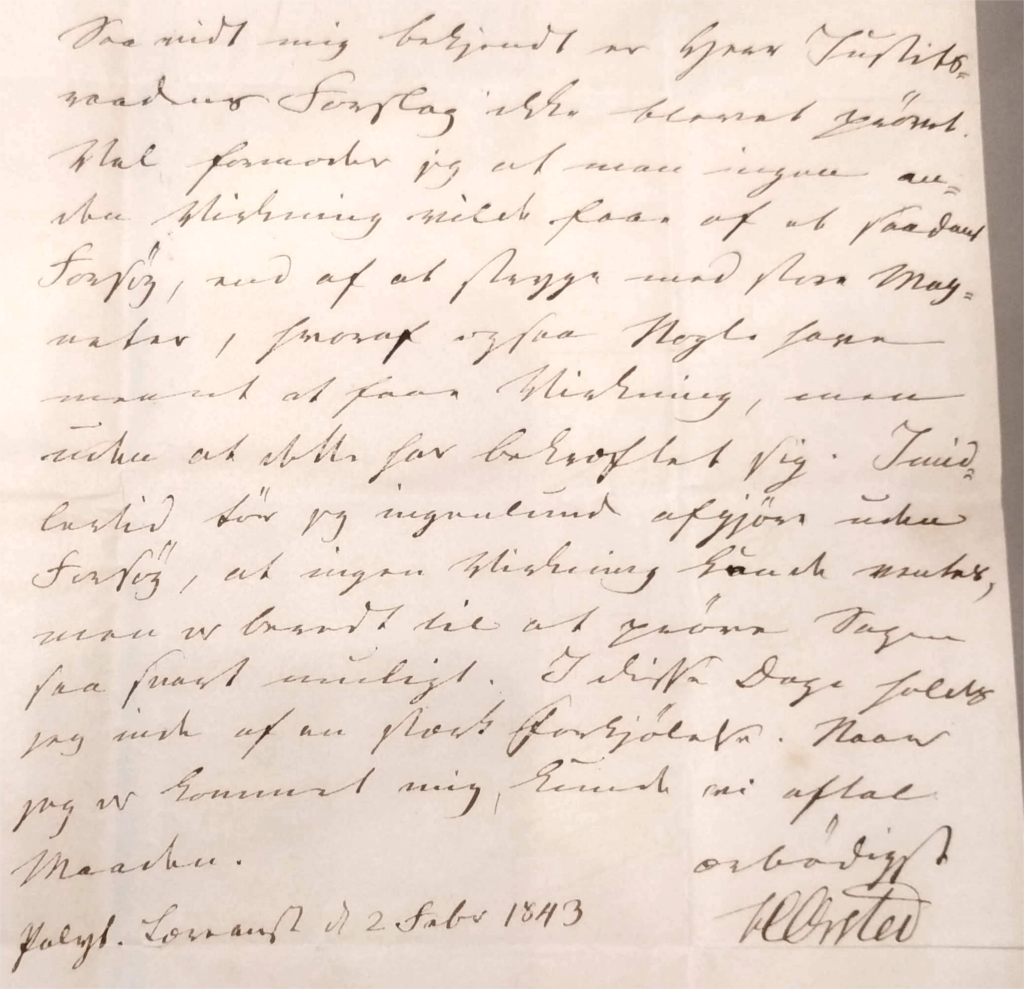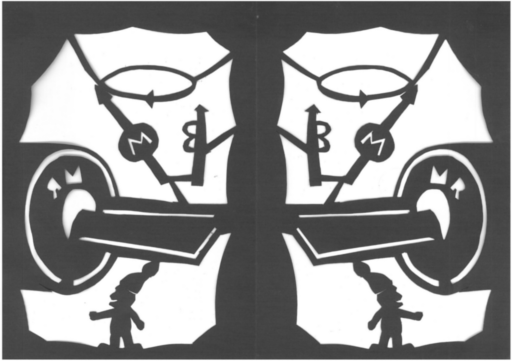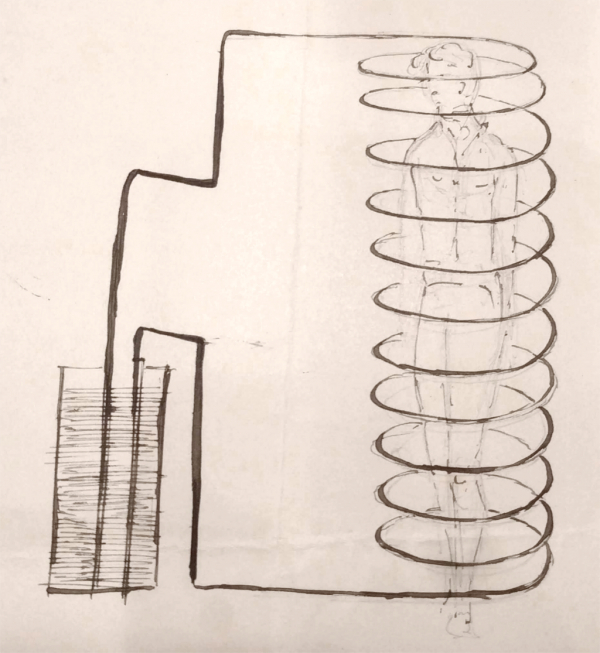In 2004, a collection of 300 newly discovered letters were acquired by The Royal Danish Library. It included writing from notabilities such as H. C. Ørsted (discoverer of electromagnetism in 1820) and H. C. Andersen (author of fairytales and more) to J. M. Thiele, author, professor, and secretary for the Danish King. Among the letters was this amazing drawing, likely from 1843. It shows a main component of a scanner, the coil magnetizing the body, but it predates MRI by 130 years. Obviously MRI was not anticipated by Ørsted: Electromagnetism and Faraday induction were known since 1820 and 1831, repectively, and basic magnetic resonance (MR) is conceptually simple, but in 1843 there was no anticipation of magnetic particles oscillating in the body like compass needles (responsible for the MR signal). Also a magnet is not a scanner, and the technology needed a century of maturation before nuclear MR even became possible.
 So what was the idea of drawing a human in a coil? A letter from H.C. Ørsted to J.M. Thiele from 1843 seems to provide a partial answer. The drawing was found together with the letter, but did not appear to have been enclosed. The letter hints that the drawing may at least partially have been made, inspired or commissioned by Thiele. This is supported by a comparison to Ørsted's other drawings that differ in style: Possibly the person was added to a drawing made by Ørsted. My amateur reading of the letter was challenging, but the result is believed to be fairly accurate (try reading before continuing, if you are Danish -- it is good fun -- click the letter to enlarge). Here is first an English translation, followed by a Danish transcript below:
So what was the idea of drawing a human in a coil? A letter from H.C. Ørsted to J.M. Thiele from 1843 seems to provide a partial answer. The drawing was found together with the letter, but did not appear to have been enclosed. The letter hints that the drawing may at least partially have been made, inspired or commissioned by Thiele. This is supported by a comparison to Ørsted's other drawings that differ in style: Possibly the person was added to a drawing made by Ørsted. My amateur reading of the letter was challenging, but the result is believed to be fairly accurate (try reading before continuing, if you are Danish -- it is good fun -- click the letter to enlarge). Here is first an English translation, followed by a Danish transcript below:
Councillor Thiele, Knight of the Order of Dannebrog [honorary titles held by Just Mathias Thiele]
As far as I know, the Councillor's suggestion has not been tried. However, I assume that no other effect of such an experiment would be obtained, than of rubbing with large magnets, which also some believe to have caused effect, but without this having been confirmed. However, I dare not decide without experiments that no effect should be expected, but am prepared to try this as soon as possible. These days I am kept inside by a severe cold. When I have recovered, we can decide the approach.
Yours reverently,
H. C. Ørsted
The Polytechnic School, February 2nd, 1843
The mentioned Polytechnic School was founded by Ørsted in 1829 is now known as the Technical Univerity of Denmark (DTU) and the DTU MR section is appropriately located on Ørsted's Square.
I have not been able to track the other half of the conversation, e.g. letters from Thiele in the extensive Ørsted archive that contain letters from other notabilities such as Faraday, Weber, and Gauss. Whether the experiments were indeed tried when Ørsted recovered is unknown to me, but as he politely points out, no effect could be expected. Also, Ørsted or others must for sure have experimented with placing body parts in smaller coils (e..g. fingers). The device to the left is likely a voltaic column driving a current through the coil, but only much stronger currents than those available at the time, would have caused an effect, e.g. muscle twitching known from magnetic stimulation, or sensory effects (e.g. dissiness) present for extremely strong static magnetic fields. The letter does not mention which effect Thiele or Ørsted imagined (if any specific), but it was already long known that electric voltages could cause muscle twitching. And since Faraday induction was also known, such effects may have been anticipated, given sufficiently strong magnetic field changes unavailable at the time.
Anecdotally, Ørsted was maybe not the first to discover electromagnetism, which he published 200 years ago in 1820. Already in 1802, G. D. Romagnosi noticed an effect of a voltaic column on a compass needle, but the finding was only published in a local newspaper and went unnoticed by the scientific community.
In any case, it is an intriguing drawing considering the similarity to modern day MRI. It is not on display, except by request via the Royal Danish Library.
The following is my amateur transcript of Ørsted's letter written in Danish:
Herr Justitsraad Thiele, Ridder af Dannebrog
Saa vidt mig bekjendt er Herr Justitsraadens Forslag ikke blevet prøvet. Blot formoder jeg at man ingen anden Virkning vilet faa af et saadant Forsøg, end af at stryge med store Magneter, hvoraf også Nogle haven menet at faa Virkning, men uden at dette har bekræftet sig. Imidlertid tør jeg ingenlunde afgjøre uden forsøg, at ingen Virkning kunde ventes, men er beredt til at prøve Sagen saa snart muligt. I disse dage holdes jeg inde af en stærk Forkølelese. Naar jeg er kommet mig, kunde vi aftale Maaden.
Ærbødigst ,
H. C. Ørsted
Polyteknisk Læreanstalt, d. 2. Febr 1843
Among Thiele's many letters were also some from H. C. Andersen, who wrote famous fairytales such as The Little Mermaid. H. C. Andersens' amazing paper cuts are probably less known. When the cut below was discovered around Christmas 2010, it was first believed to be created by Andersen himself, possibly around 1850. However, the piece is now widely believed to be crafted by H. C. Lundell somewhat later.

The photo material and text on this page by Lars G. Hanson can be used freely without asking permission.



